A Brief History of Dragon Ball Video Games, Part 2
by Todd Ciolek,The first half of our History of Dragon Ball Games took us from the initial titles spawned by the long-running manga and anime series up to the release of Dragon Ball GT: Final Bout in 1997. As we'll see, the decade to follow brought new things for Dragon Ball.
When we last left Dragon Ball in the late 1990s, it was in the midst of a quiet phase in Japan. Akira Toriyama's manga had wrapped up, and the anime adaptations fizzled after 1996's Dragon Ball GT lasted a mere 64 episodes--impressive for any series but a shonen-manga juggernaut like Dragon Ball. Video games based on Dragon Ball were in similar decline, and despite a booming PlayStation market, the game industry rode out the decade without any more Dragon Ball concessions. Bandai had other anime licenses to explore, and so did audiences across Japan.
Not so in North America. As a new century dawned, kids and older fans alike were catching Dragon Ball Z every weekday on Cartoon Network. They were hashing out arguments over the correct pronunciations of “kaio-ken” and whether or not Goku could beat Superman in a Kryptonite-free fight. And they were paying well over $100 for Dragon Ball GT: Final Bout, a mediocre fighting game Bandai had localized a few years ago.
Dragon Ball Z became a standard-bearer for a new generation of North American anime fans, right alongside Pokemon, Sailor Moon, and, no matter how much old-school mecha fans pouted, Gundam Wing. Game companies took a year or two to notice, but it wasn't long before they started filling the Dragon Ball gap. Thus began a new era, one where Dragon Ball games were often made as much for Western audiences as they were for Japan.
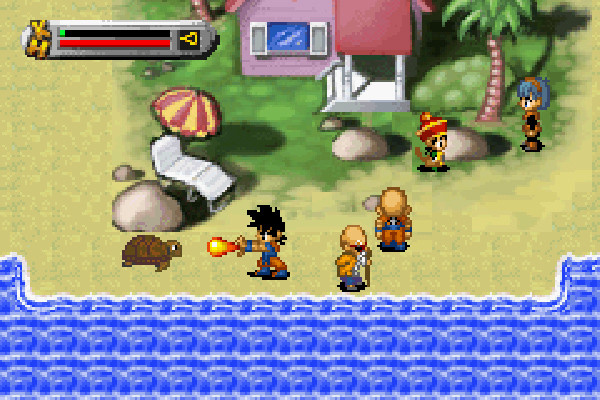
A good example of this newfound worldwide appeal lies in Dragon Ball Z: The Legacy of Goku (above) for the Game Boy Advance. An overhead-view action/RPG, it's the work of American developer Webfoot Technologies and international publisher Infogrames, and it arrived in Europe and North America in 2002, before even considering Japan. The original The Legacy of Goku chronicles early Dragon Ball Z story arcs through somewhat simple, kid-friendly play mechanics and unspectacular graphics, though it did well enough to spawn a series with The Legacy of Goku II appeared in 2003 and Buu's Fury in 2004.
The Game Boy Advance soon drowned in tie-ins for every popular cartoon of the day, and the uncreatively titled Dragon Ball Z: Collectible Card Game was especially mercenary. A simple recreation of Score's Dragon Ball Z card game, it never arrived in Japan and bribed players with an actual bonus card inside the box.
But what of those Dragon Ball fans who stuck with the Game Boy Color, Nintendo's 1998 upgrade of its original handheld? They could find solace in Dragon Ball Z: Legendary Saiyan Warriors, a Banpresto RPG that crammed in the TV show's storyline right up to and including the Majin Buu nonsense. It was developed in Japan, but in a turn typical of this new age of Dragon Ball fandom, it came to North America first.
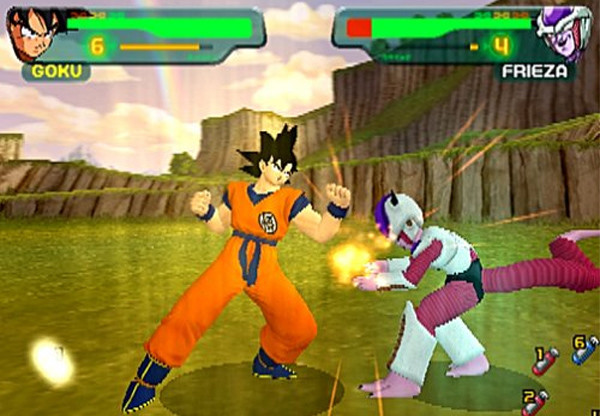
The Game Boy Advance had tested the waters for Dragon Ball games, and something more elaborate was in store. Dragon Ball Z: Budokai (above) seemed every bit the game that fans had wanted: a 3-D fighter with cel-shaded graphics perfectly in line with the anime series. Arriving on the PlayStation in 2002 and the Nintendo GameCube a year later, Budokai was relatively simple at its heart, but developer Dimps had a surer hand than other studios when it came to fighting games. Dragon Ball fans didn't mind many hiccups when they could spend Christmas that year pitting Saiyan against Saiyan or absorbing other characters with Cell's creepiest ability.
By 2003, Dragon Ball games were once again a yearly sight--and have been ever since. Budokai 2 arrived on the PlayStation 2 before the year's end, expanding its story mode and roster well beyond the Cell Saga. Game Boy Advance owners had more options, if not necessarily better ones: atop the second Legacy of Goku game, Webroot developed Dragon Ball Z: Taiketsu, a mediocre 2-D fighter.

Dragon Ball games even mounted a comeback in Japan. Budokai and other titles saw release there after their North American and European debuts, and Bandai delivered a Japanese exclusive for their Wonderswan. Designed by former Nintendo creative genius Gunpei Yokoi, the Wonderswan was a perpetual underdog to Nintendo's Game Boy and Game Boy Advance. It never wanted for Bandai's anime adaptations, however, and in 2003 an extensive remake of the Famicom's old Dragon Ball 3: Gokuden (above) joined the One Piece and Gundam license buffet on the Wonderswan Color.
The tradition of annual Dragon Ball games, usually fighters, was routine in Japan throughout the early 1990s, and now it knew global scale. Dragon Ball Z: Budokai 3's holiday 2004 debut added more characters, even bringing Dragon Ball GT into the mix, though it skipped the GameCube entirely.
Dragon Ball's popularity also brought disappointment to anyone hoarding old copies of Dragon Ball GT: Final Bout for retirement funds: Atari released both it and Ultimate Battle 22 as PlayStation budget titles in 2004. Any American reviewers who noticed the games were quick to savage them, but Atari at least saved the impulsive Dragon Ball faithful a little money.
The Game Boy Advance outings picked up that year with Dragon Ball Z: Supersonic Warriors, a 2-D fighting game and moderate improvement on Taiketsu. That might owe to the pedigree of developer Arc Systems Works, creators of the stunning Guilty Gear games. They'd do wonders with the license, but not for many years.
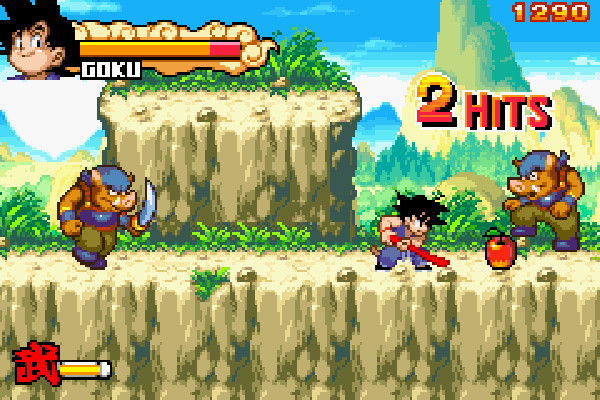
It might seem unfair that the original Dragon Ball often went unnoticed amid this success, as the original, goofier tales of kid Goku never caught on in America like the more reckless Dragon Ball Z. All was not lost, however, as Bandai and developer Dimps crafted Dragon Ball: Advance Adventure (above) for the GBA in 2004. A breezy side-scroller, it covers Goku's early escapades with regular brawling, flying Nimbus stages, and one-on-one boss battles. The concept remains very much in line with the earliest Dragon Ball games, but Advanced Adventure benefits from better hardware and Dimps' experience.
Dragon Ball grew more popular in Japan as the decade continued. Bandai's Carddass system of card-based arcade games, though hard to pronounce without a snicker among English-speakers, enjoyed many anime licenses. One became Data Carddass Dragon Ball Z in 2005 and a sequel in 2006.
Arcade patrons who preferred their fighting games without cards and Carddasses could try Super Dragon Ball Z around the same time. Presenting 3-D fighting with distinct manga stylings, the game is the work of Arika and Crafts & Meister--both underappreciated developers formed by ex-Capcom talent. Super Dragon Ball Z wouldn't languish in arcade ethers, as a PlayStation 2 port appeared in 2006.
Dragon Ball games tended to favor the PlayStation 2 among home consoles, but Dragon Ball Z: Sagas thoughtfully also visited the GameCube and even the Xbox, a platform often underserved by anime licenses. The game's 3-D brawling recreations of Dragon Ball Z's storyline aren't impressive, though it's ambitious enough to span most of the related anime's storyline.
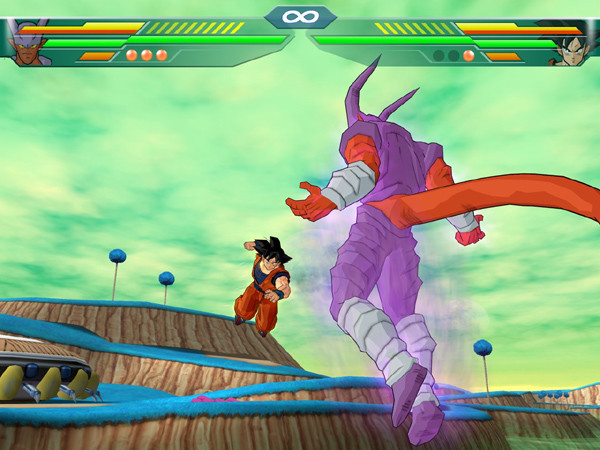
Fans were spoiled by 2005, anyway. Developer Spike put together Dragon Ball Z: Budokai Tenkaichi (above), a 3-D fighter that played out in wider stages than most of its licensed brethren. Despite the name, it's not part of the Budokai series. It didn't need to be, though, because Budokai Tenkaichi became a series of its own, earning sequels in 2006 and 2007.
The Game Boy Advance finished up its Dragon Ball collection in 2005 with the unspectacular Dragon Ball GT: Transformations brawler, though the game hinted at a follow-up that never arrived. Nintendo's new DS handheld swiftly took over, featuring Dragon Ball Z: Supersonic Warriors 2. It's again a 2-D fighter, though with troubled developer Cavia taking over for Arc Systems Works. Goku also appeared in Jump Super Stars and Jump Ultimate Stars, two Shonen Jump multi-manga crossover DS fighters exclusive to Japan...but also seen at import vendors and even Best Buy for a time. Slightly less common of a sight was Battle Stadium D.O.N., a Japan-only GameCube and PlayStation 2 fighter that mixed Naruto, One Piece, and Dragon Ball into a brawling extravaganza like Smash Bros.
Just to keep the Budokai and Budokai Tenkaichi nomenclature confusing, Dragon Ball Z: Shin Budokai brought the Dimps-developed original Budokai line to the PSP in 2016. Despite the portable platform, it brought aboard most of the console Budokai features, plus a story mode based on the 1995 film Dragon Ball Z: Fusion Reborn. The sequel, 2007's Shin Budokai: Another Road, abandoned established anime in favor of a new storyline that resurrected Majin Boo in the alternate timeline that spawned Future Trunks.
Fortunately, you didn't need a PSP or a GBA or a PlayStation 2 to get a Dragon Ball game. Not long after Nintendo launched the motion-sensing Wii in 2006, Bandai released Battle Taikan Kamehameha in Japan. A basic device plugged directly into the TV, it uses two motion-reading wristbands for controllers, thus inviting players to gesture and wave in order to launch ki blasts and punches. Grunting and screaming is optional.
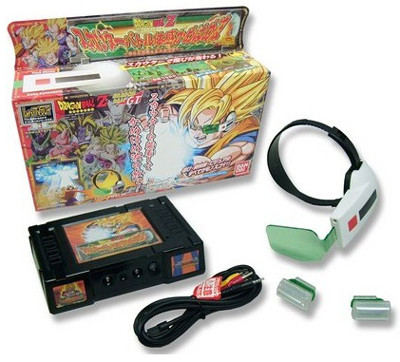
A second self-contained Taikan Kamehameha arrived in 2007, and a 2008 crossover game, Dragon Ball Z X One Piece: Battle Taikan Gomu Gomu Kamehameha pitted Goku and company against the Straw Hat Pirates. The best title in the series, however, is clearly Scouter Battle Taikan Kamehameha, which uses a Scouter headset to read enemy stats and facilitate obnoxious Internet memes.
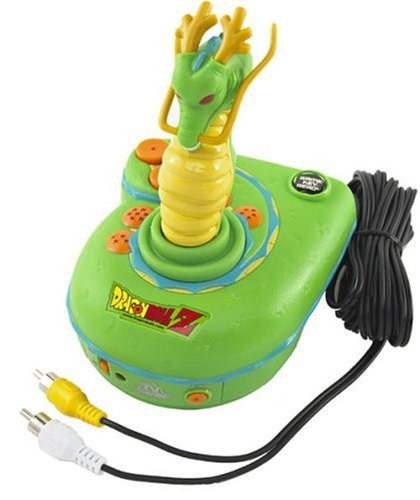
The Battle Taikan Kamehameha series was exclusive to Japan, but Jakks Pacific gave America its own Dragon Ball plug-and-play around the same time. The Dragon Ball Z TV Games bundle is a green joystick styled like a dragon's head, and its three self-contained games include a Pong-like ki battle, a basic fighting game, and a Dragon Ball pinball table. The titles within are hardly the cream of Dragon Ball adaptations, and the dragon-head joystick is uncomfortable and easily broken by younger players. Even so, it's the perfect gift if you ever end up the Secret Santa for a Dragon Ball fan.
In some ways, 2007 found Dragon Ball comfortable in its habits. Arcade-goers in Japan had the card-battle game Bakuretsu Impact, with its sequels, 2008's W Bakuretsu Impact and 2009's Dragon Battlers, not far behind. Worldwide, Wii and PlayStation 2 owners had the third Budokai Tenkaichi fighter. And DS owners had Harukanaru Densetsu, an RPG that used cards (virtual ones, thankfully) to run its battle system.
The following year proved less staid. Dragon Ball Z: Burst Limit brought the Budokai formula (the regular Dimps-made Budokai, that is) to the Xbox 360 and PlayStation 3 with the panache of new in-battle cutscenes. Those who hadn't yet upgraded to the new systems had a rough equivalent with Dragon Ball Z: Infinite World for the PlayStation 2. Dragon Ball also managed a cameo in Dr. Slump: Arale Chan for the DS. It pretty much required a Goku guest spot, as the game is based on Toriyama's first big manga and anime hit.

Even the oft-sidelined events of Goku's youth got some attention with Dragon Ball: Origins for the DS. Game Republic, an underappreciated studio founded by former Capcom and Konami bigwig Yoshiki Okamoto, distilled the Dragon Ball storyline down into an overhead action game, making the most of the DS system's touch screen and propensity for cartoonish 3-D characters. A 2009 sequel (above) took the storyline through the witch Baba's challenges, and a third Origins may well have come along if Game Republic hadn't collapsed in 2011.
The 2009 live-action Dragonball film may rank as the least-loved piece of the entire franchise. It'd be nice to say that the PSP fighting game inspired by Dragonball Evolution rises above its material. Alas, it's a standard fighter built from PSP Budokai bones, and no Dragon Ball fan bothered much when better alternatives awaited.
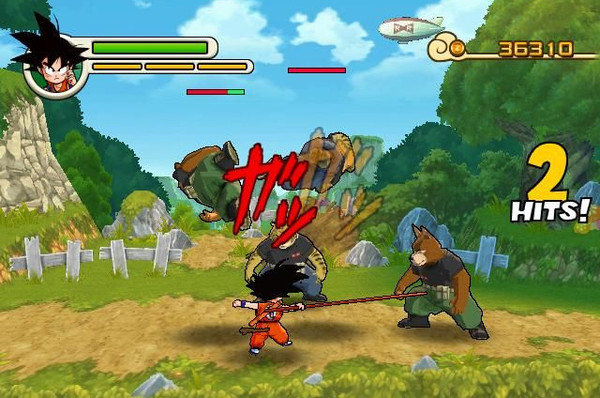
What alternatives? The DS received Dragon Ball Z: Attack of the Saiyans, a straightforward RPG covering the initial arcs of the anime series. Wii owners could nab Dragon Ball: Revenge of King Piccolo (above), an exuberant, cel-shaded action game that embellishes Dragon Ball's story with a few original tales--and a playable guest appearance by Dr. Slump's Arale. It's a creditable outing from developer Media.Vision (Wild Arms, Chaos Rings), considering that the Wii was at this time turning into a garbage dump for every licensed game from Alvin and Chipmunks to Heathcliff.
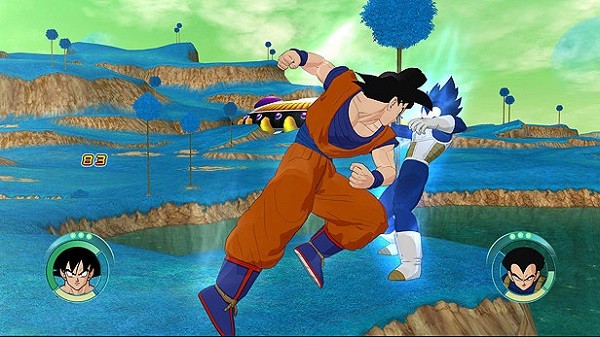
The main attraction for 2009, however, was Dragon Ball: Raging Blast. An evolution of Spike's Budokai Tenkaichi series, it let players thrash each other in environments both spacious and easily destroyed. It didn't attract that many casual players beyond the Dragon Ball fan base, but Raging Blast was back with a slightly improved sequel in 2010.
As if to make up for foisting Dragonball Evolution on the PSP, Dragon Ball Z: Tenkaichi Tag Team provided a return to the familiar in 2010. Its two-on-two matches put a rarer spin on the usual violence, which like most Dragon Ball fighters uses a huge cast (70 characters, in this case) and anime-faithful renditions to make up for uncomplicated battles.
A major force in Dragon Ball games arose in 2010 with Dragon Ball Heroes, the latest in Bandai's now-annual line of arcade games that mixed Dragon Ball fights with physical cards. It's grown exponentially in the years since its release, amassing the largest roster of any Dragon Ball fighter and rearranging characters and continuities like pop art collages. It wouldn't come to North America, though one suspects it'd do just fine in a rowdy Dave & Buster's.
The most intriguing Dragon Ball release of 2010 is Dragon Ball Online. It mapped the world of Dragon Ball Z onto a massive online RPG, letting players fly around as humans, namekians, or whatever Buu was supposed to be. It stayed exclusive to Korea, Hong Kong, and Taiwan before shutting down in 2013. This wouldn't be the last online outing for Dragon Ball, however.
The old Dragon Ball Butoden fighting-game series was long retired by this point, made irrelevant by yearly installments of Budokais and Raging Blasts. Yet it returned with Dragon Ball Kai: Ultimate Butoden on the DS, just in time for the Kai remastering of the original Dragon Ball Z cartoon. The game featured largely two-dimensional fights with 3-D graphics andcfamiliar button-mashing combos. To top it all off, Ultimate Butoden never left Japan, providing fans with that nostalgic rush of importing a modest Dragon Ball fighting game just like they did in the 1990s!
Another milestone of 2011: an arcade Dragon Ball Z fighter that didn't use cards. Zenkai Battle Royale offered 3-D tag-team battles with the usual four dozen or so Dragon Ball characters, though it didn't merit any release beyond Japan as far as Bandai cared. Thus the honor of that year's major Dragon Ball Z fighter went to Ultimate Tenkaichi for the Xbox 360 and PlayStation 3. It brought some gameplay refinement and visual polish to the Budokai Tenkaichi aesthetic, plus a story mode where the player's customized avatar roamed the Dragon Ball skies and brawled with the cast.
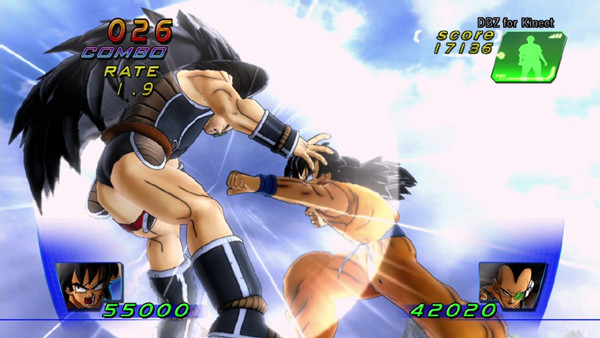
Microsoft's motion-sensing Kinect bar did not innately cry out for a Dragon Ball game, but someone at Namco Bandai must've noticed all the kids and cosplayers striking Kamehameha poses at anime conventions. Dragon Ball Z for Kinect (above) uses a first-person viewpoint and tracks the player's body to enact special moves, and like the majority of lesser Kinect outings it's a bumbling ordeal. At least Bandai Namco bribed fans by including the North America debut of the mini-movie Episode of Bardock.
Strangely enough, the Kinect experiment was Dragon Ball Z's big game for 2012. Only Budokai HD Collection, an enhanced bundle of the first and third Budokai fighters, joined it with the usual Xbox 360 and Playstation 3 appearances.
A brief lull ensued in 2013. No major Dragon Ball games visited North America while the Dragon Ball Kai series took a break from the airwaves. Even in Japan the selection was sparse outside of the Nintendo 3DS. Dragon Ball Heroes: Ultimate Mission scaled down the arcade game's fisticuffs and collectible cards into a handheld title, with sequels in 2014 and 2017. J Legend Retsuden gave the handheld a collection of anime-derived games from the Famicom and Super Famicom. At least Dragon Ball titles outnumbered the compilation's Saint Seiya and Yu Yu Hakusho offerings.
Smartphone games rounded out the 2013 Dragon Ball offerings. Dragon Ball Tap Battle boiling down ferocious combat to screen-presses, with Ultimate Swipe doing the same the following year. Dragon Ball RPG: Shonen-hen offered a more complex quest based on Goku's goofier days. None of these games was translated for the West, but running Japanese Android or iOS games is far less taxing than a $90 import.
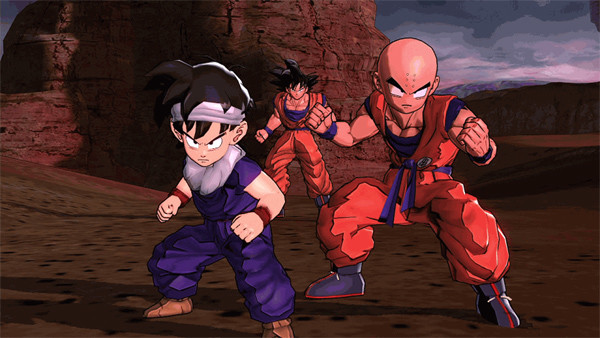
A slight delay pushed the annual Dragon Ball fighter to 2014. Battle of Z (above) cast its ambitions into multiplayer combat, letting four-character teams square off in online modes on the PlayStation 3, Xbox 360, and Vita. Dragon Ball also shared a roster with dozens of other manga celebrities in J-Stars Victory Vs., though it's hard to pick out Goku, Vegeta, and Frieza in the massive roster. J-Stars technically marked Dragon Ball's debut on the new PlayStation 4, which shared the game with the PS3 and Vita. This was, of course, the last year Sony valued the Vita.
Dragon Ball Online had breathed its last by 2015, but its central idea lived on through Dragon Ball Xenoverse. While it's another Dimps-made fighting game with aerial battles and typical excess, Xenoverse lets players create their own characters, with even Frieza's race among the options.
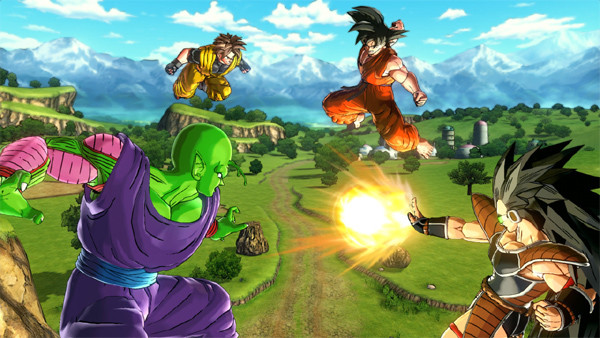
The storyline sticks the player's avatar at the center of a time-travel quest that reveals various Dragon Ball moments, and an online mode sees player-crafted fighters joining up or doing battle. Xenoverse straddled the PlayStation and Xbox generations (with a PC port as well), but the 2016 sequel stuck to the newest systems: the PlayStation 4, Xbox One, PC, and eventually the Nintendo Switch.
The Butoden series emerged yet again with Dragon Ball Z: Extreme Butoden for the 3DS. Swapping the previous Butoden's 3-D graphics with sharper hand-drawn style courtesy of Arc System Works. The mechanics play it relatively simple, and even though the game boasts over 100 Dragon Ball characters, only a few dozen are playable. At least it did fans the favor of handily showing up in North America.
Bandai continued building up Dragon Ball in Japan's arcades. Dragon Ball Heroes saw many upgrades, the latest being a Super version in 2017, and a newcomer discovered yet another way to combine collectible knicknacks and arcade games. Debuting in 2015, Dragon Ball Discross used toy discs and a Scouter headset to enhance its fighting-game mechanics, and regulars like Goku and Trunks joined up with an energetic kid hero straight out of generic toy-anime central casting.
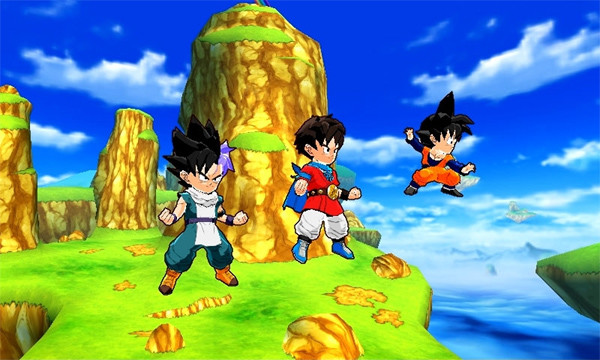
Dragon Ball Fusions )above) for the 3DS is a unique find among Dragon Ball games. It isn't so much the storyline, which sticks the player's custom avatar in a tournament roundup of popular characters. It's more the game's strategic battles, full of enemies bouncing around like billiard balls, and the rampant use of the Fusion power to combine dozens of Dragon Ball characters. Oh, and Arale. She sneaks into Dragon Ball games all the time.
Dragon Ball: Dokkan Battle is not the first smartphone game spawned by the series, but it's the first one loosed on a worldwide stage. The gameplay itself hinges on arranging characters in strategic slots and watching the resulting destruction, but the real hook lies in acquiring heaps of Dragon Ball characters through random draws and microtransactions. Of course, Dokkan Battle is hardly alone in exploiting fans through their favorite characters.
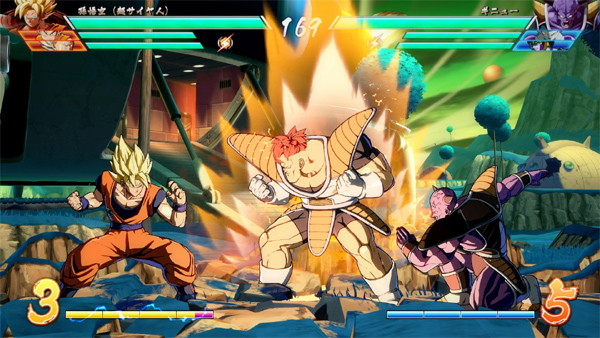
The latest game in sight is Dragon Ball Fighterz, out now on the PlayStation 4, Xbox One, and Steam. It's a gorgeously animated fighting game from Arc System Works, and it even managed to introduce a halfway novel new antagonist with Android 21. Some critics have deemed it the best Dragon Ball game ever.
If that's not a fiercely contested honor, it's at least one with a long history behind it--and a solid future ahead of it. Now that it's nearly as popular in the West as it ever was in Japan, Dragon Ball will likely endure as long as there's an anime industry of any sort. And it'll bring video games along for the ride.
discuss this in the forum (3 posts) |
this article has been modified since it was originally posted; see change history